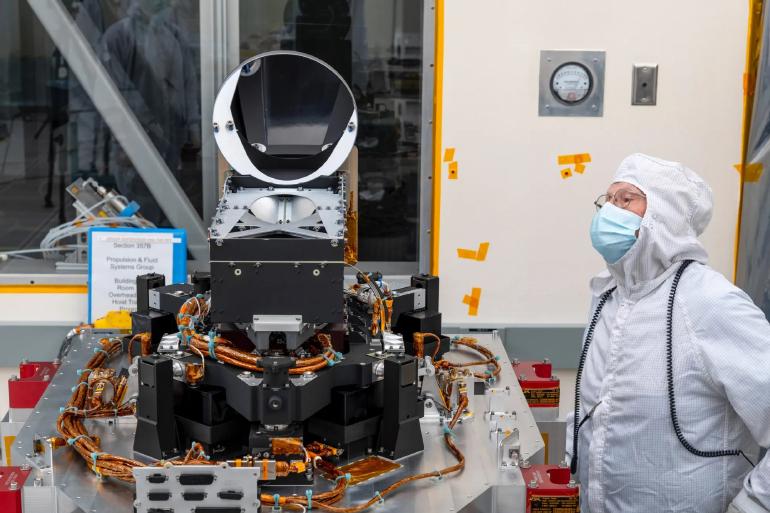Palomar Observatory receives data via laser beam from far beyond the Moon
- HPWREN connectivity helped bringing us a step closer to an interplanetary internet -
A few weeks ago, NASA's Psyche spacecraft was launched from the Kennedy Space Center in Florida aboard a SpaceX Falcon Heavy rocket. This mission has enabled a new milestone at the Palomar Observatory, where its large 5-meter single-mirror telescope is now able to receive data streams via a laser beam from space. This advanced communication method is transmitting information from a distance well beyond the Moon, marking a significant advancement in deep space data transmission.
The size of the spacecraft body is 4.9 m tall, 2.2 m wide and 2.4 m deep. Highlights from the 13 October 2023 launch of this spacecraft at 10:19 EDT from NASA's KSC include that it will travel 2.2 billion miles to a metal-rich asteroid in the main asteroid belt between Mars and Jupiter, which is shown in this 70 second video. A much longer Official NASA Broadcast video is also available, with the rocket ignition located about 51 minutes into the video.
The laser communication was facilitated by the DSOC technology demonstration on the spacecraft, a NASA experiment that will test optical communications. The 5 kW near-infrared terrestrial beam originates at JPL’s Table Mountain facility near Wrightwood, California, and will deliver a beacon and a low-rate uplink data to the flight laser transceiver, with the spacecraft sending at a high rate at only 4W through the same 22 cm telescope it receives data on. This is why there is the need for the big Caltech Palomar Observatory mirror, so the data can be retrieved from the by then very weak signal from the far away space vehicle.
The Deep Space Optical Communications (DSOC) technology demonstration's flight laser transceiver is shown at NASA's Jet Propulsion Laboratory in Southern California in April 2021.
Image credit: NASA/JPL-Caltech
In a short DSOC video, Bill Klipstein, DSOC Project Manager at JPL, explains that “DSOC stands for "Deep Space Optical Communications" which is using lasers to communicate at high rate, and the application of that to deep space beyond the Moon is what the DSOC project is about.
“The notion of being able to communicate to have video to astronauts on Mars is actually part of the vision that NASA has for optical communication. DSOC consists of a flight terminal that flies on the Psyche spacecraft and then a ground network that has a station for transmitting up to the spacecraft and then receiving laser signal down from the spacecraft.
“DSOC is being implemented as a technology demonstration to show that we know how to build terminals that can do this with the idea that in the future they can be flown as part of the operational communication system on future missions, and we designed the terminal to operate out to about Mars for this distance and Psyche on its cruise actually does a Mars flyby, so it's an excellent vehicle for the demonstration of deep space optical communication. DSOC is the first time that there will be optical communication demonstrated beyond the Moon.”
In this deep-space test NASA fired the earthbound laser from about 16 million kilometers away. With the moon's shortest distance being about 363,300 km away from earth, this amounts to about 44 times the minimum distance to the moon, or about one third the theoretical minimum of 54.6 million km to Mars, according to this article.
Andy Boden, Caltech Optical Observatories - California Institute of Technology, points out that “yes of course the experiment used/uses HPWREN-enabled data connectivity at the observatory,” as HPWREN is Palomar’s primary means of connecting their big data instruments to the internet via the San Diego Supercomputer Center since 2001.
Looking towards the future, Internet Pioneer Vint Cerf, for whom one world is clearly not enough, summarizes "NASA's interest in laser communication is extremely important because with increasing numbers of missions with longer lifetimes, we need to move data much faster just to keep up with demand. Lasers can help and the Psyche test is a step towards making laser comms a standard feature of interplanetary communication. It also has great and positive implications for the Solar System Internet being developed by NASA, ESA, JAXA and KARI along with the Internet Society's Interplanetary chapter (ipnsig.org) and a growing number of commercial enterprises."
More information and other related materials:
- Deep Space Optical Communications (DSOC) Flight Laser Transceiver
- NASA Psyche Press kit
